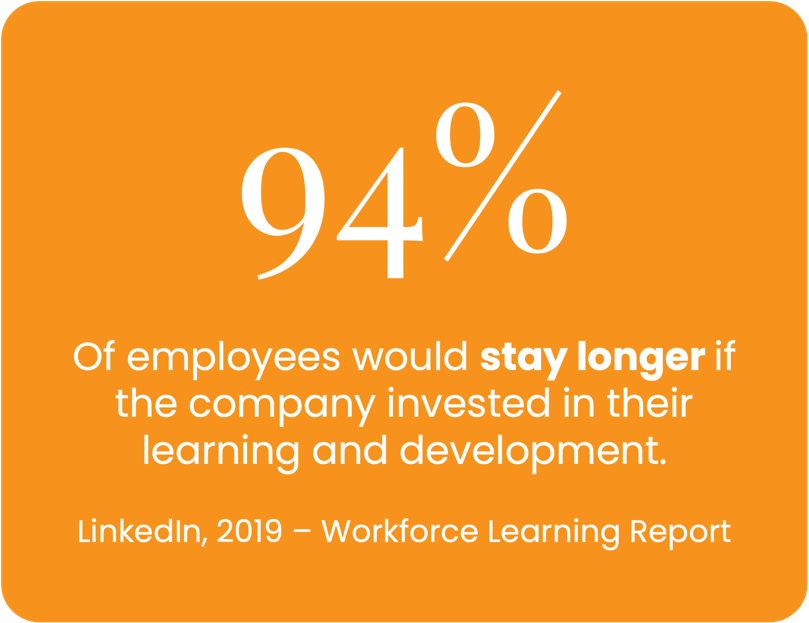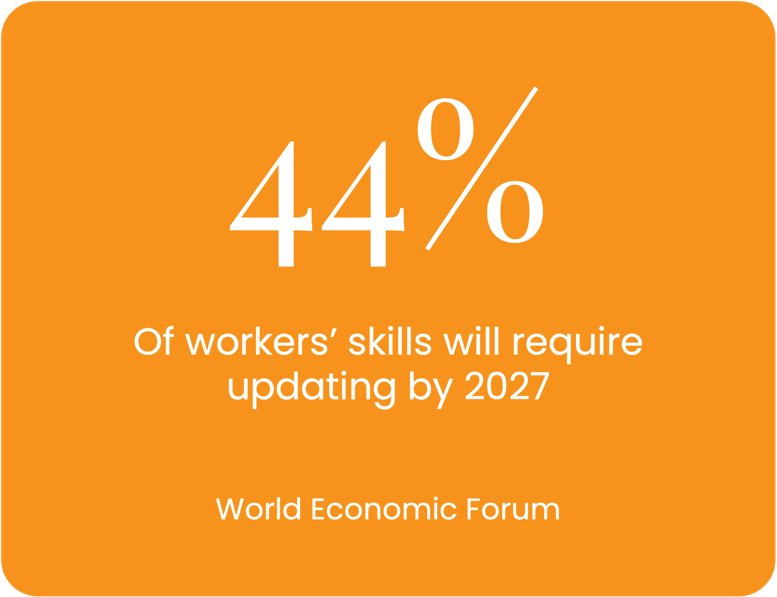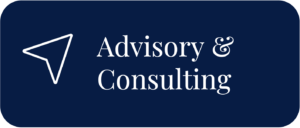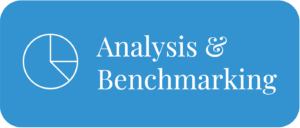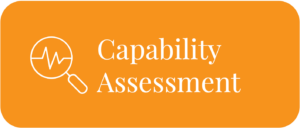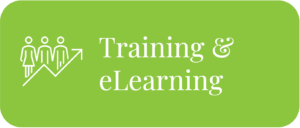Picture this: you’re leading a team, and things are humming along nicely. But then, a new project lands on your desk that requires skills your team doesn’t have. Suddenly, you’re scrambling to fill the gaps and keep things on track. Sound familiar?
If you’re nodding your head, you’re not alone. According to a 2021 McKinsey survey, a whopping 87% of companies worldwide already have skill gaps or expect them to crop up in the next five years. And let me tell you, these gaps can be a real headache. They can put a serious dent in your productivity, competitiveness, and even your bottom line..
Do you know exactly where your team shines and where they could use a bit of polishing up?
Whether you’re in procurement, contract management, or supply chain, one thing’s for sure: to knock it out of the park, you need the right skills, knowledge, and strategic insight in your corner. But here’s the kicker: a lot of businesses are in the dark about where their teams excel and where those pesky skill gaps are hiding.
That’s where a Skills Gap Analysis (SGA) comes in. Think of it as your trusty roadmap to workforce development. It gives you the cold, hard data you need to pinpoint exactly where to invest in training, talent strategies, and learning interventions to close those gaps and build a team that’s ready for anything.
Now, an SGA isn’t about pointing fingers or putting anyone on the spot. It’s all about growth, plain and simple.
For your team members, it’s a game-changer. It gives them a clear picture of where they stand and where they need to grow to crush their career goals.
It’s your key to lining up your talent strategy with your business goals, securing those all-important training budgets, and nurturing your future leaders.
In this guide, we’re going to take you through the nitty-gritty of running a skills gap analysis. We’ll dive into why it’s an absolute must-have and showcase how technology-driven assessments can give you the edge in a world that’s getting more complex by the day.
What is a Skills Gap Analysis?
A skills gap analysis is a structured process that identifies the difference between the skills an organisation currently has and the skills it needs to achieve its strategic objectives. It provides a clear, data-driven picture of workforce capability, enabling organisations to make informed decisions about training, hiring, and talent development.
A skills gap occurs when employees lack the proficiency required for their current roles, even if positions are filled
At an individual level, a skills gap analysis helps employees understand their competencies relative to job requirements and career aspirations. It empowers them with insights into areas for improvement, guiding personalised learning and professional growth. IBM, for instance, uses AI-powered tools to provide personalised skill recommendations and learning paths for its employees, resulting in a 10% increase in internal job mobility and a significant reduction in attrition rates.
For teams, this analysis identifies collective strengths and weaknesses, ensuring the right mix of skills for optimal performance. It also helps leaders allocate resources effectively, ensuring teams are equipped to meet current and future demands. Google’s Project Oxygen, an internal study on team effectiveness, found that the right mix of skills and clear role definition were among the top factors contributing to high-performing teams.
At the organisational level, a skills gap analysis supports long-term workforce planning by aligning talent development with business strategy. It helps leadership anticipate skill shortages, prepare for industry shifts, and make targeted investments in training programs. PwC’s 2020 Talent Trends report reveals that 74% of CEOs are concerned about the availability of key skills, and 32% plan to significantly increase investment in upskilling programs.
Key Benefits
- Strategic Alignment: Ensures that workforce skills align with business goals and industry trends.
- Training Optimisation: Directs learning and development investments where they will deliver the highest ROI. A study by Accenture found that for every dollar invested in training, companies receive $4.53 in return – a 353% ROI.
- Leadership Development: Identifies potential leadership gaps, allowing for proactive succession planning. With the average age of C-suite executives rising and 10,000 Baby Boomers reaching retirement age daily, developing the next generation of leaders is critical.
- Talent Retention & Employee Engagement: Demonstrates a commitment to professional growth, fostering a culture of continuous learning. LinkedIn’s 2019 Workforce Learning Report found that 94% of employees would stay at a company longer if it invested in their learning and development.
Why Conduct a Skills Gap Analysis?
The procurement and supply chain landscape is evolving rapidly, driven by globalisation, digital transformation, regulatory changes, and shifting stakeholder expectations.
A 2019 Deloitte study found that 79% of CPOs believe their current teams do not have sufficient skills to deliver on their procurement strategy. Is this still true today?
Regardless, organisations must ensure their workforce possesses the right competencies to navigate these complexities and drive business success. A skills gap analysis provides the clarity needed to stay ahead.
Procurement Performance & Business Impact Research underscores the strategic value of procurement.
The IBM Chief Procurement Officer (CPO) Study found that organisations with high-performing procurement functions achieve 7.12% profit growth, compared to only 5.83% for companies with less advanced procurement.
However, to capitalise on procurement’s impact, businesses need professionals with the right skills in analytics, negotiation, supplier relationship management, and risk mitigation..
The Looming Talent Shortage By 2030, an estimated 10,000 Baby Boomers will reach retirement age daily, triggering one of the largest corporate “brain drains” in history. The procurement and supply chain fields are already experiencing a shortage of skilled professionals, with 46% of supply chain leaders citing talent shortage as a top challenge. This makes it imperative for companies to develop internal talent rather than relying solely on external hiring. A skills gap analysis helps organisations build robust succession plans by identifying future leaders and ensuring knowledge transfer before critical expertise is lost.
Gaining a Competitive Advantage
Companies that proactively invest in upskilling their workforce don’t just mitigate risk—they gain a strategic edge. Accenture found that companies with comprehensive upskilling programs generate 28% higher revenue growth than those without. A well-executed skills gap analysis ensures organisations remain agile, innovative, and resilient in the face of disruptions. It also enhances employee engagement, as professionals are more likely to stay with employers who invest in their career development.
LinkedIn’s 2019 Workforce Learning Report reveals that 94% of employees would stay at a company longer if it invested in their learning and development.
As McKinsey notes, “The most forward-looking [procurement] leaders are using this inflection point to materially differentiate their organisations’ capabilities and, by extension, their companies’ competitive advantage.”
Skills Gap Analysis is About Growth NOT Performance Reviews
One of the biggest challenges in conducting a Skills Gap Analysis is overcoming employee fear and skepticism. The moment a new assessment is introduced, employees may think, “Wait, we already have a performance review in September—why are we doing this now?”
This confusion can lead to resistance, disengagement, and even a reluctance to participate honestly. In fact, a study by the NeuroLeadership Institute found that traditional performance reviews can trigger a “fight or flight” response in employees, leading to defensiveness and disengagement.
The key to success is psychological safety—ensuring employees understand that an SGA is not an individual performance evaluation but a tool for growth, development, and investment in their future.
Psychological safety is defined as “a shared belief held by members of a team that the team is safe for interpersonal risk-taking.” In the context of an SGA, this means creating an environment where employees feel comfortable being honest about their skill levels without fear of negative consequences.
Unlike traditional performance reviews, which often determine promotions, bonuses, or job security, a skills gap analysis is about identifying opportunities to enhance workforce capability. It’s a forward-looking process that helps organisations prepare for future challenges and opportunities. By contrast, performance reviews are typically retrospective, focusing on past achievements and shortcomings.
An SGA helps organisations build better learning and development roadmaps, secure budgets for high-quality training, and justify more structured professional development initiatives.
It provides the data needed to make strategic investments in workforce upskilling. For example, after conducting a skills gap analysis, AT&T discovered that only about half of its 250,000 employees had the skills needed for the company’s future vision. In response, they launched a massive reskilling effort, committing $1 billion to employee education and professional development programs3.
When communicating about an SGA, leaders must emphasise that “This isn’t about finding weaknesses—it’s about finding opportunities.”
The goal is to identify areas where the company can invest in its people, not to penalise individuals for skills they haven’t yet developed. This framing helps create a growth mindset, where employees see skill gaps as opportunities for learning rather than personal deficiencies.
When employees understand that the goal is career growth, not performance grading, they are far more likely to engage with the process honestly, leading to more accurate insights and better development outcomes.
This transparency is essential because the accuracy of an SGA depends on the quality of the data it collects. If employees feel safe to share their true skill levels, the organisation gains a clearer picture of its capabilities and can make more targeted investments in training and development.
Ultimately, a skills gap analysis is a commitment to employees, not a critique of them—and when framed correctly, it becomes a powerful tool for both personal and organisational success. By fostering psychological safety and emphasising growth, companies can transform the skills gap analysis from a dreaded assessment into an opportunity for employees to chart their own career paths and for the business to build the workforce of the future.
Steps to Conduct a Skills Gap Analysis
A skills gap analysis is a structured approach to identifying and addressing workforce capability gaps.
Step 1: Define the Scope
Before conducting a Skills Gap Analysis, organisations must first establish why they are doing it and who it should focus on. Many businesses assume their workforce is equipped for current and future challenges—but when was the last time this was validated? In many cases, a skills framework may have been developed years ago, based on outdated market conditions, evolving job roles, or prior business priorities.
Defining the scope starts with identifying the business need.
Is there concern that procurement professionals lack strategic capability beyond transactional tasks? Are contract managers struggling with commercial awareness and risk mitigation in an increasingly complex regulatory landscape? Does supply chain management have the technical and analytical expertise to navigate digital transformation? Understanding the why behind an SGA ensures the analysis produces relevant, actionable insights.
Scope also determines the level of assessment:
- Individual-level: Helps employees understand their own development needs, supporting career progression and targeted training.
- Team-level: Ensures collective capability for project execution, optimising collaboration and functional effectiveness.
- Organisation-wide: Provides leadership with a comprehensive workforce capability map, guiding budget allocation for Learning & Development (L&D), hiring strategies, and long-term workforce planning.
Finally, alignment with business goals is critical. Is the objective to improve procurement performance, enhance supplier negotiations, build leadership pipelines, or prepare for a major industry shift? By defining scope with clarity, organisations can ensure skills gap analysis drives tangible business value—not just another HR exercise.
Step 2: Establish a Capability Framework
A capability framework is the foundation of a robust Skills Gap Analysis (SGA). It defines the essential skills and competencies required for success in a given role, function, or industry. Without a clearly defined framework, organisations risk evaluating employees against outdated expectations or misaligned job requirements, leading to ineffective training investments and misdirected talent strategies.
At its core, a capability framework answers three key questions:
- What skills does the organisation value?
Every company has a unique strategic focus—whether it’s cost efficiency in procurement, supplier innovation, contract risk mitigation, or supply chain resilience. The capability framework should reflect these organisational priorities. For example, a procurement team in a highly regulated industry may place more emphasis on compliance and contract governance, whereas a fast-growing tech firm might prioritise agility in supplier negotiations and market engagement.
- What skills do employees need to do their jobs today?
Current job roles are evolving, and many professionals are operating under outdated expectations. A structured framework identifies critical competencies for immediate performance, ensuring employees have the technical knowledge, strategic thinking, and digital proficiency required to succeed. Without this clarity, organisations risk overlooking existing skill deficiencies, leading to inefficiencies and missed opportunities.
- What skills do employees need to do their jobs tomorrow?
Future-proofing the workforce requires anticipating industry trends, regulatory shifts, and emerging technologies. Procurement and supply chain teams, for instance, must develop expertise in AI-driven analytics, ESG (Environmental, Social, and Governance) compliance, and risk-based decision-making. The capability framework serves as a forward-looking guide, ensuring employees are developing skills that will be essential in the years ahead, not just meeting today’s requirements.
By establishing a clear and dynamic capability framework, organisations create a benchmark for assessing workforce readiness, aligning talent development with business strategy, and ensuring that employees evolve in step with industry demands.
Step 3: Assess Current Skills
With a capability framework in place, the next step is to assess your team’s current skill levels. This process provides a data-driven snapshot of employee competencies, allowing organisations to pinpoint where skills align with expectations and where gaps exist.
How the Assessment Process Works
Every employee receives a private login to a secure assessment platform, where they complete assigned evaluations over a 2- to 6-week period—depending on the depth and breadth of the process. The assessments are designed to be objective, structured, and aligned with the capability framework, ensuring they accurately measure both knowledge and practical application of skills.
After completing each assessment, participants receive a personalised feedback report containing insights into their performance, along with helpful tools, tips, and learning recommendations. The assessments can be customised to align with organisational needs, ensuring that businesses gain relevant and actionable insights rather than generic data.
Types of Assessments
Organisations can use a combination of assessment methods to build a comprehensive skills profile:
- Knowledge Assessments – Objective, standardised evaluations that measure technical knowledge and functional expertise.
- Skill assessments – Employees rate their own proficiency, providing insights into confidence levels and perceived strengths.
At www.skillsgapanalysis.com, we provide industry-leading assessments tailored to procurement, contract management, and supply chain professionals.
Procurement Assessments
Procurement professionals must master the end-to-end procurement lifecycle. Our assessments are structured around eight core dimensions. These dimensions align with global best practices, ensuring organisations can assess, benchmark, and develop procurement talent effectively.
Contract Management Assessments
Effective contract management is critical to maximising value from supplier relationships. Our assessments evaluate professionals on dimensions like Contract lifecycle management, Commercial awareness, Risk mitigation and compliance.
There is also another type of assessment which is focusses on case study scenarios, asking participants how they might handle each scenario – a highly practical approach to assessing on-the-ground contract management capabilities.
Supply Chain Assessments
A high-performing supply chain is a competitive differentiator. Our assessments are structured around eight core dimensions like Inventory control, Demand planning and Logistics and supplier performance management.
By assessing supply chain professionals against industry benchmarks, organisations can build resilience, improve efficiency, and reduce operational risk.
Why Our Assessments Work
- Online & Scalable – Employees complete assessments remotely, allowing businesses to evaluate geographically dispersed teams.
- Instant Reporting – Individualised reports highlight strengths, weaknesses, and tailored learning recommendations based on the 70:20:10 model (experiential learning, peer collaboration, and formal training).
- Team-Wide Benchmarking – Organisations receive aggregated insights, identifying capability gaps across departments or job levels.
- Actionable Development Plans – Each assessment provides targeted recommendations, ensuring that training efforts focus on critical skill deficiencies rather than generic learning programs.
Step 4: Analyse the Gaps
With assessment data in hand, the next step is to identify gaps between current and required skills. This analysis helps prioritise training efforts where they will have the most impact.
By using data visualisation tools, organisations can create heat maps or benchmark reports that highlight deficiencies across teams or functions. For instance, if contract negotiation skills are consistently low across procurement teams, targeted training initiatives can be introduced.
This step also helps uncover hidden strengths, allowing companies to redeploy talent effectively rather than solely focusing on hiring.
Step 5: Develop Targeted Solutions
Addressing skill gaps requires tailored learning and development strategies rather than a generic, one-sise-fits-all approach. The 70:20:10 learning model is particularly effective:
- 70% experiential learning (on-the-job training, stretch assignments)
- 20% social learning (mentorship, peer coaching)
- 10% formal training (e-learning, workshops, certifications)
Personalised learning paths ensure that employees receive the right training at the right time, maximising engagement and retention.
By aligning learning investments with business objectives, organisations ensure that upskilling efforts directly contribute to performance improvement.
Step 6: Implement Change & Monitor Progress
A skills gap analysis is only valuable if it leads to actionable change. Organisations must establish a structured implementation plan with clear milestones and accountability measures.
Key steps include:
- Developing a roadmap with short-, medium-, and long-term goals.
- Setting KPIs to measure training effectiveness and skill development.
- Conducting periodic reassessments to ensure continuous improvement.
Tracking progress ensures that investments in skills development yield measurable business impact, from improved procurement efficiency to stronger supplier negotiations.
The Role of Technology in Skills Gap Analysis
Technology has revolutionised skills gap analysis, making it faster, more scalable, and more precise than traditional manual assessments. Automation enables organisations to assess workforce capabilities efficiently, eliminating human bias while ensuring data accuracy. For example, IBM’s Watson Talent Platform uses AI to analyse employee skills and identify gaps at scale. Digital platforms allow businesses to evaluate thousands of employees simultaneously, generating insights in real-time.
Additionally, technology enables benchmarking against industry standards, allowing organisations to compare their workforce capabilities with best-in-class practices. This is particularly valuable in the procurement and supply chain fields, where skill requirements evolve rapidly. By leveraging adaptive assessments, which adjust question difficulty based on employee responses, businesses can tailor evaluation models to reflect their unique operating environment. This ensures that the insights gained are both relevant and actionable.
To illustrate, consider a scenario where a procurement team needs to upskill in data analytics. An adaptive assessment platform could begin with basic data literacy questions and progressively move to more complex problem-solving tasks. The platform would then benchmark the team’s performance against industry peers, identifying specific skill gaps and recommending targeted training modules.
By using sophisticated assessment platforms, organisations can transform their skills gap analysis from a reactive exercise into a proactive strategy for capability development. Rather than waiting for performance issues to surface, businesses can continuously monitor workforce skills and take corrective action before gaps impact results. This allows procurement, contract management, and supply chain teams to continuously evolve, staying ahead of market disruptions and regulatory changes.
As the World Economic Forum notes, “The accelerating pace of technological, demographic and socio-economic disruption is transforming industries and business models…making upskilling and reskilling an urgent imperative.”
By leveraging technology-driven skills gap analysis, organisations can build the agile, future-ready workforce needed to thrive in this new reality.
Skills Gap Analysis: Industry-Leading Assessment Solutions
At www.skillsgapanalysis.com, Comprara offers advanced skills assessment solutions for procurement, contract management, and supply chain professionals.
Unlike generic skills tests, our dual-assessment methodology evaluates both knowledge and skills, providing an accurate representation of capability gaps.
This approach ensures that organisations don’t just measure what employees know—they identify what they can actually do in practice.
Each domain—procurement, contract management, and supply chain—features two assessments:
- Knowledge Evaluation – Measures theoretical understanding of best practices, processes, and methodologies.
- Skills Assessment – Assesses practical application of knowledge through scenario-based questions.
By mapping knowledge against skills, organisations can identify mismatches—for example, individuals who overestimate their capabilities (akin to the Dunning-Kruger effect) or those who are highly skilled but lack confidence in their abilities.
With www.skillsgapanalysis.com, organisations can take a data-driven approach to workforce development, ensuring that their procurement, contract management, and supply chain teams stay competitive, adaptable, and future-ready.
Want to see it in action?
Request a demo today.
Building a Future-Ready Workforce
Market volatility, digital transformation, and shifting regulatory landscapes demand a workforce that is agile, data-savvy, and strategically capable. A recent Deloitte study found that 72% of CPOs do not believe their teams have the skills to deliver on their procurement strategy. Without continuous capability development, organisations risk falling behind.
To understand why this skill gap exists, let’s consider the evolving role of procurement. In the past, procurement was largely an operational function, focused on cost reduction and transactional efficiency.
Procurement is increasingly seen as a strategic partner, driving innovation, mitigating risk, and creating value across the supply chain.
This shift requires a new set of competencies, such as advanced analytics, supplier relationship management, and sustainability expertise.
A data-driven approach to skills gap analysis ensures that talent management decisions are based on real insights, not assumptions. By systematically identifying skill deficiencies, organisations can allocate training budgets effectively, develop leadership pipelines, and future-proof their workforce.
For example, after conducting a skills assessment, a global pharmaceutical company discovered that its procurement team lacked advanced data analytics capabilities. In response, they invested in a targeted upskilling program, which resulted in a 15% increase in productivity and a 20% reduction in supplier risk.
The benefits of closing skill gaps extend beyond individual performance.
Organisations that invest in employee development see higher levels of engagement, retention, and innovation. A study by the Association for Talent Development found that companies with comprehensive training programs have 218% higher income per employee and 24% higher profit margins\. Instead of reactive hiring to fill capability gaps, companies can cultivate talent from within, fostering stronger engagement, retention, and succession planning.
To illustrate the potential impact, consider the case of a global technology company that implemented a comprehensive procurement upskilling program. By assessing current capabilities, identifying future skill needs, and delivering targeted training, they were able to reduce maverick spending by 30%, improve supplier performance by 25%, and generate over $10 million in cost savings.
As the pace of change accelerates, the ability to quickly identify and close skill gaps will separate the leaders from the laggards. The question is not whether to invest in skills development, but how quickly and effectively organisations can do so.
To see our core assessments:
- Procurement Skills Self Assessment
- Procurement Knowledge Evaluation
- Contract Management Skills Self Assessment
- Contract Management Knowledge Evaluation
- Supply Chain Self Assessment
- Supply Chain Knowledge Evaluation
To see ALL of our assessments > https://www.skillsgapanalysis.com/capability-assessments/
Research on Skills Gap Analysis
The global labor market is undergoing significant transformations driven by technological advancements, demographic shifts, and evolving industry demands. These changes have exacerbated skill gaps, creating challenges for businesses and employees alike. This report synthesises findings from recent studies and statistical analyses to explore the determinants of skill gaps, their economic impacts, and strategies for mitigation.
Defining Skills Gaps and Shortages
A skills gap occurs when employees lack the proficiency required for their current roles, even if positions are filled. This differs from a skills shortage, which refers to unfilled vacancies due to a lack of qualified candidates. According to Statistics Canada, 56.1% of businesses reported skills gaps in 2022, with prevalence increasing with company size: 33.1% of micro businesses faced gaps compared to 93% of large enterprises Sectoral disparities are pronounced, with technical, problem-solving, and customer service skills being the most deficient.
Economic and Organisational Impacts
Productivity and Profitability Losses
Skills gaps impose substantial costs. The World Economic Forum estimates that 44% of workers’ skills will require updating by 2027. In the UK, 72% of organisations report increased workloads due to unfilled roles, while 78% cite reduced profitability. At the macroeconomic level, labour mismatches could result in $8.5 trillion in lost annual revenues globally by 2030.
Wage and Employment Dynamics
Mismatched skills disproportionately affect earnings. Workers over-qualified for their roles experience a 7% wage penalty, while under-qualified workers face even greater losses. During economic downturns, resolving skills mismatches could reduce joblessness by one-third, highlighting the interplay between skill alignment and labour market resilience.
Drivers of the Skills Gap Crisis
Automation and AI are reshaping job requirements faster than educational systems can adapt. In healthcare, aging populations and medical advancements demand new technical competencies. Similarly, manufacturing now prioritises robotics and adaptive problem-solving over traditional mechanical skills.
The retirement of Baby Boomers is depleting institutional knowledge. In trades, 3 million positions are expected to remain vacant by 2028 due to insufficient skilled replacements. This generational shift exacerbates shortages in leadership and specialised roles, forcing companies to redesign jobs around available talent5.
Mitigation Strategies and Best Practices
Reskilling and Upskilling Initiatives
McKinsey reports that 87% of companies address gaps through reskilling, focusing on critical thinking, leadership, and data analysis. For example, IBM’s AI-driven upskilling programs tailor learning paths to emerging tech needs, though specific methodologies weren’t detailed in available sources.
Adaptive Recruitment Practices
Organisations are increasingly hiring for potential rather than exact qualifications. Gartner notes that 58% of HR leaders prioritise adaptability and learning agility over static skill sets. This approach, combined with freelance workforce integration, enhances flexibility in dynamic markets.
Organisational Agility
Companies should conduct biannual skills audits to anticipate emerging gaps. Deloitte’s procurement surveys emphasise the need for real-time analytics to track workforce capabilities against strategic objectives.



